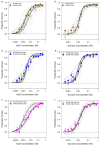The Influence of Roux-en-Y Gastric Bypass and Diet on NaCl and Sucrose Taste Detection Thresholds and Number of Circumvallate and Fungiform Taste Buds in Female Rats
- PMID: 35215527
- PMCID: PMC8880222
- DOI: 10.3390/nu14040877
The Influence of Roux-en-Y Gastric Bypass and Diet on NaCl and Sucrose Taste Detection Thresholds and Number of Circumvallate and Fungiform Taste Buds in Female Rats
Abstract
Roux-en-Y gastric bypass (RYGB) in rats attenuates preference for, and intake of, sugar solutions. Additionally, maintenance on a high-fat diet (HFD) reportedly alters behavioral responsiveness to sucrose in rodents in short-term drinking tests. Due to the fact that the behavioral tests to date rely on the hedonic value of the stimulus to drive responsiveness, we sought to determine whether taste detection thresholds to sucrose and NaCl are affected by these manipulations as measured in an operant two-response signal detection paradigm. Female rats were maintained on HFD or chow for 10 weeks, at which point animals received either RYGB or SHAM surgery followed by a gel-based diet and then powdered chow. Upon recovery, half of the rats that were previously on HFD were switched permanently to chow, and the other rats were maintained on their presurgical diets (n = 5-9/diet condition × surgery group for behavioral testing). The rats were then trained and tested in a gustometer. There was a significant interaction between diet condition and surgery on NaCl threshold that was attributable to a lower value in RYGB vs. SHAM rats in the HFD condition, but this failed to survive a Bonferroni correction. Importantly, there were no effects of diet condition or surgery on sucrose thresholds. Additionally, although recent evidence suggests that maintenance on HFD alters taste bud number in the circumvallate papillae (CV) of mice, in a subset of rats, we did not find that diet significantly influenced taste pores in the anterior tongue or CV of female rats. These results suggest that any changes in sucrose responsiveness in intake/preference or hedonically oriented tests in rats as a function of HFD maintenance or RYGB are not attributable to alterations in taste sensitivity.
Keywords: Roux-en-Y gastric bypass; bariatric surgery; gustatory system; high-fat diet; rat; taste; taste pores; taste sensitivity; taste thresholds.
Conflict of interest statement
The authors declare no conflict of interest.
Figures









Similar articles
-
Gastric bypass in rats does not decrease appetitive behavior towards sweet or fatty fluids despite blunting preferential intake of sugar and fat.Physiol Behav. 2015 Apr 1;142:179-88. doi: 10.1016/j.physbeh.2015.02.004. Epub 2015 Feb 3. Physiol Behav. 2015. PMID: 25660341 Free PMC article.
-
Gastric bypass in female rats lowers concentrated sugar solution intake and preference without affecting brief-access licking after long-term sugar exposure.Am J Physiol Regul Integr Comp Physiol. 2020 May 1;318(5):R870-R885. doi: 10.1152/ajpregu.00240.2019. Epub 2020 Feb 21. Am J Physiol Regul Integr Comp Physiol. 2020. PMID: 32083966 Free PMC article.
-
Alterations of sucrose preference after Roux-en-Y gastric bypass.Physiol Behav. 2011 Oct 24;104(5):709-21. doi: 10.1016/j.physbeh.2011.07.025. Epub 2011 Jul 30. Physiol Behav. 2011. PMID: 21827777 Clinical Trial.
-
Taste- and flavor-guided behaviors following Roux-en-Y gastric bypass in rodent models.Appetite. 2020 Mar 1;146:104422. doi: 10.1016/j.appet.2019.104422. Epub 2019 Aug 28. Appetite. 2020. PMID: 31472198 Review.
-
Proceedings from the 2018 Association for Chemoreception Annual Meeting Symposium: Bariatric Surgery and Its Effects on Taste and Food Selection.Chem Senses. 2019 Mar 11;44(3):155-163. doi: 10.1093/chemse/bjy076. Chem Senses. 2019. PMID: 30517609 Free PMC article. Review.
Cited by
-
High-sucrose diet exposure is associated with selective and reversible alterations in the rat peripheral taste system.Curr Biol. 2022 Oct 10;32(19):4103-4113.e4. doi: 10.1016/j.cub.2022.07.063. Epub 2022 Aug 16. Curr Biol. 2022. PMID: 35977546 Free PMC article.
-
The Neural Code for Taste in the Nucleus of the Solitary Tract of Rats with Obesity Following Roux-En-Y Gastric Bypass Surgery.Nutrients. 2022 Oct 4;14(19):4129. doi: 10.3390/nu14194129. Nutrients. 2022. PMID: 36235781 Free PMC article.
References
MeSH terms
Substances
Grants and funding
LinkOut - more resources
Full Text Sources
Research Materials

